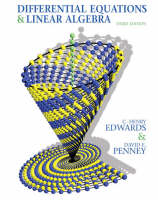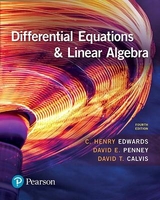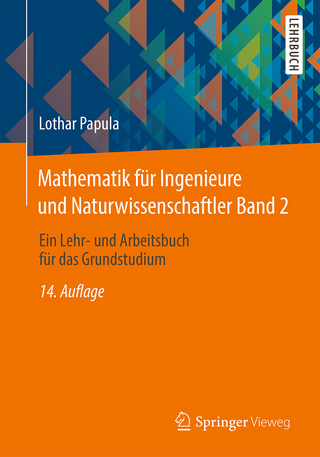
Differential Equations and Linear Algebra
Pearson (Verlag)
978-0-13-605425-2 (ISBN)
- Titel erscheint in neuer Auflage
- Artikel merken
Acclaimed authors Edwards and Penney combine core topics in elementary differential equations with those concepts and methods of elementary linear algebra needed for a contemporary combined introduction to differential equations and linear algebra. Known for its real-world applications and its blend of algebraic and geometric approaches, this text discusses mathematical modeling of real-world phenomena, with a fresh new computational and qualitative flavor evident throughout in figures, examples, problems, and applications. In the Third Edition, new graphics and narrative have been added as needed—yet the proven chapter and section structure remains unchanged, so that class notes and syllabi will not require revision for the new edition.
C. Henry Edwards is emeritus professor of mathematics at the University of Georgia. He earned his Ph.D. at the University of Tennessee in 1960, and recently retired after 40 years of classroom teaching (including calculus or differential equations almost every term) at the universities of Tennessee, Wisconsin, and Georgia, with a brief interlude at the Institute for Advanced Study (Princeton) as an Alfred P. Sloan Research Fellow. He has received numerous teaching awards, including the University of Georgia's honoratus medal in 1983 (for sustained excellence in honors teaching), its Josiah Meigs award in 1991 (the institution's highest award for teaching), and the 1997 statewide Georgia Regents award for research university faculty teaching excellence. His scholarly career has ranged from research and dissertation direction in topology to the history of mathematics to computing and technology in the teaching and applications of mathematics. In addition to being author or co-author of calculus, advanced calculus, linear algebra, and differential equations textbooks, he is well-known to calculus instructors as author of The Historical Development of the Calculus (Springer-Verlag, 1979). During the 1990s he served as a principal investigator on three NSF-supported projects: (1) A school mathematics project including Maple for beginning algebra students, (2) A Calculus-with-Mathematica program, and (3) A MATLAB-based computer lab project for numerical analysis and differential equations students. David E. Penney, University of Georgia, completed his Ph.D. at Tulane University in 1965 (under the direction of Prof. L. Bruce Treybig) while teaching at the University of New Orleans. Earlier he had worked in experimental biophysics at Tulane University and the Veteran's Administration Hospital in New Orleans under the direction of Robert Dixon McAfee, where Dr. McAfee's research team's primary focus was on the active transport of sodium ions by biological membranes. Penney's primary contribution here was the development of a mathematical model (using simultaneous ordinary differential equations) for the metabolic phenomena regulating such transport, with potential future applications in kidney physiology, management of hypertension, and treatment of congestive heart failure. He also designed and constructed servomechanisms for the accurate monitoring of ion transport, a phenomenon involving the measurement of potentials in microvolts at impedances of millions of megohms. Penney began teaching calculus at Tulane in 1957 and taught that course almost every term with enthusiasm and distinction until his retirement at the end of the last millennium. During his tenure at the University of Georgia he received numerous University-wide teaching awards as well as directing several doctoral dissertations and seven undergraduate research projects. He is the author of research papers in number theory and topology and is the author or co-author of textbooks on calculus, computer programming, differential equations, linear algebra, and liberal arts mathematics.
CHAPTER 1. First-Order Differential Equations
1.1 Differential Equations and Mathematical Models
1.2 Integrals as General and Particular Solutions
1.3 Slope Fields and Solution Curves
1.4 Separable Equations and Applications
1.5 Linear First-Order Equations
1.6 Substitution Methods and Exact Equations
CHAPTER 2. Mathematical Models and Numerical Methods
2.1 Population Models
2.2 Equilibrium Solutions and Stability
2.3 Acceleration–Velocity Models
2.4 Numerical Approximation: Euler's Method
2.5 A Closer Look at the Euler Method
2.6 The Runge–Kutta Method
CHAPTER 3. Linear Systems and Matrices
3.1 Introduction to Linear Systems
3.2 Matrices and Gaussian Elimination
3.3 Reduced Row-Echelon Matrices
3.4 Matrix Operations
3.5 Inverses of Matrices
3.6 Determinants
3.7 Linear Equations and Curve Fitting
CHAPTER 4. Vector Spaces
4.1 The Vector Space R3
4.2 The Vector Space Rn and Subspaces
4.3 Linear Combinations and Independence of Vectors
4.4 Bases and Dimension for Vector Spaces
4.5 Row and Column Spaces
4.6 Orthogonal Vectors in Rn
4.7 General Vector Spaces
CHAPTER 5. Higher-Order Linear Differential Equations
5.1 Introduction: Second-Order Linear Equations
5.2 General Solutions of Linear Equations
5.3 Homogeneous Equations with Constant Coefficients
5.4 Mechanical Vibrations
5.5 Nonhomogeneous Equations and Undetermined Coefficients
5.6 Forced Oscillations and Resonance
CHAPTER 6. Eigenvalues and Eigenvectors
6.1 Introduction to Eigenvalues
6.2 Diagonalization of Matrices
6.3 Applications Involving Powers of Matrices
CHAPTER 7. Linear Systems of Differential Equations
7.1 First-Order Systems and Applications
7.2 Matrices and Linear Systems
7.3 The Eigenvalue Method for Linear Systems
7.4 Second-Order Systems and Mechanical Applications
7.5 Multiple Eigenvalue Solutions
7.6 Numerical Methods for Systems
CHAPTER 8. Matrix Exponential Methods
8.1 Matrix Exponentials and Linear Systems
8.2 Nonhomogeneous Linear Systems
8.3 Spectral Decomposition Methods
CHAPTER 9. Nonlinear Systems and Phenomena
9.1 Stability and the Phase Plane
9.2 Linear and Almost Linear Systems
9.3 Ecological Models: Predators and Competitors
9.4 Nonlinear Mechanical Systems
CHAPTER 10. Laplace Transform Methods
10.1 Laplace Transforms and Inverse Transforms
10.2 Transformation of Initial Value Problems
10.3 Translation and Partial Fractions
10.4 Derivatives, Integrals, and Products of Transforms
10.5 Periodic and Piecewise Continuous Input Functions
References for Further Study
Appendix A: Existence and Uniqueness of Solutions
Appendix B: Theory of Determinants
Answers to Selected Problems
Index
APPLICATION MODULES
The modules listed here follow the indicated sections in the text. Most provide computing projects that illustrate the corresponding text sections. Maple, Mathematica, and MATLAB versions of these investigations are included in the Applications Manual that accompanies this textbook.
1.3 Computer-Generated Slope Fields and Solution Curves
1.4 The Logistic Equation
1.5 Indoor Temperature Oscillations
1.6 Computer Algebra Solutions
2.1 Logistic Modeling of Population Data
2.3 Rocket Propulsion
2.4 Implementing Euler's Method
2.5 Improved Euler Implementation
2.6 Runge-Kutta Implementation
3.2 Automated Row Operations
3.3 Automated Row Reduction
3.5 Automated Solution of Linear Systems
5.1 Plotting Second-Order Solution Families
5.2 Plotting Third-Order Solution Families
5.3 Approximate Solutions of Linear Equations
5.5 Automated Variation of Parameters
5.6 Forced Vibrations and Resonance
7.1 Gravitation and Kepler's Laws of Planetary Motion
7.3 Automatic Calculation of Eigenvalues and Eigenvectors
7.4 Earthquake-Induced Vibrations of Multistory Buildings
7.5 Defective Eigenvalues and Generalized Eigenvectors
7.6 Comets and Spacecraft
8.1 Automated Matrix Exponential Solutions
8.2 Automated Variation of Parameters
9.1 Phase Portraits and First-Order Equations
9.2 Phase Portraits of Almost Linear Systems
9.3 Your Own Wildlife Conservation Preserve
9.4 The Rayleigh and van der Pol Equations
| Erscheint lt. Verlag | 13.11.2008 |
|---|---|
| Sprache | englisch |
| Maße | 203 x 254 mm |
| Gewicht | 1570 g |
| Themenwelt | Mathematik / Informatik ► Mathematik ► Algebra |
| Mathematik / Informatik ► Mathematik ► Analysis | |
| ISBN-10 | 0-13-605425-0 / 0136054250 |
| ISBN-13 | 978-0-13-605425-2 / 9780136054252 |
| Zustand | Neuware |
| Haben Sie eine Frage zum Produkt? |
aus dem Bereich



